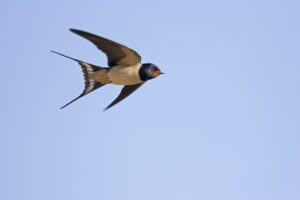
If bats are the silent vacuums of nocturnal skies, ridding the air of mosquitoes, then swallows are their vociferous daytime counterparts. Agile and talkative, swallows dart back and forth, scooping up insects on the wing.
Many homeowners are loath to welcome swallows to their property because they’re familiar with the birds’ penchant for nesting above doorways, porches, and decks. Cleaning beneath these nests and trying to prevent the swallows’ return can become a second job during the summer months.
However, by strategically placing a few nesting boxes around one’s home, a person can avoid the aggravation of fouled walkways and take full advantage of these little birds’ bug-catching talents.
Most swallows are very tolerant of people, but—of the dozen or so species of swallows that are found in North America—purple martins, tree swallows, violet-green swallows, and barn swallows are most likely to utilize nesting boxes built by humans.
Purple Martins
- The largest North American swallow, purple martins are known for their tendency to nest in colonial man-made houses. However, they will use cavities in trees or single-nest houses as well, particularly in the West.
- Purple martins are found throughout the US, but are relatively absent from the Rocky Mountains.
- Martins have triangular wings that are proportionately shorter than those of other swallows.
- Adult males are purplish black, with darker wings and tail; females and immature birds have light-gray bellies and purplish upperparts. Tails are long, broad and forked.
Tree Swallows
- A relatively large swallow with wide-based, triangular wings and a slightly forked tail.
- Tree swallows nest across North America from Alaska to eastern Canada and southward along both coasts. They are rare in the Great Plains or Great Basin, but their range extends southward along the eastern Rockies.
- Adult males are dark greenish-blue on back and wings with pure white underparts. The head exhibits a sharp demarcation between the white throat and the dark cap that extends to below the eye. Females and immatures are duller in color, but exhibit the same clean line along the sides of the head.
Violet-green Swallows
- Similar to tree swallows at first glance, but smaller and with a slightly different flight pattern. Violet-green swallows glide less and flap their wings more quickly than tree swallows.
- Summer range is from central Alaska to southern Mexico, extending east to Dakotas, western Nebraska and western Texas.
- Males are intense, metallic green along shoulders and back with purple on rump and wings. Underparts are white, with white extending onto face behind eye (unlike tree swallow). Females are brownish above; immatures are gray above with sooty-brown breasts.
Barn Swallows
- This familiar swallow occurs nearly worldwide, nesting in any location that provides overhead cover.
- North American range extends from southern Alaska, across the Yukon and northern Canadian provinces to the Atlantic, and south to Mexico.
- Accomplished flyers that constantly swoop back and forth, pulling wingtips to body at completion of each downstroke; flight is swift and acrobatic with little gliding.
- Males, females, and juveniles are similarly marked, though males are more brightly colored. Upperparts are steely bluish-black; underparts are rust-colored or reddish-buff. Tails are deeply forked.
Swallow Nesting Basics
- Purple martins will happily nest side-by-side in “condos” with separate nesting compartments. They prefer to have some open space around their nests, and they especially like nearby bodies of open water.
- Tree swallows and violet-green swallows are a bit more territorial than martins, though their territories are relatively small. Both will occupy the same boxes that bluebirds will use; nest boxes should be placed 50 to 100 feet apart, preferably facing away from each other.
- Nesting boxes should have ventilation holes on the sides, but drainage holes aren’t necessary and may invite ants, which will kill nestlings.
- Nesting boxes with one hinged side are easier to clean; old nesting material should be removed at least once every two years in late autumn.
- Barn swallows will nest on platforms that are placed on walls 6 – 12 inches below overhanging eaves or roofs. Several breeding pairs will occupy an old barn or shed, but each pair requires a separate nesting platform.
